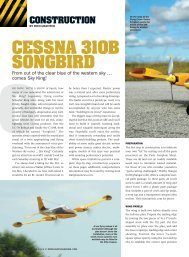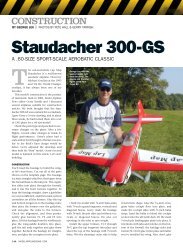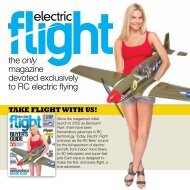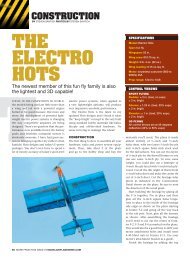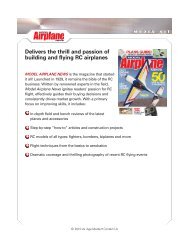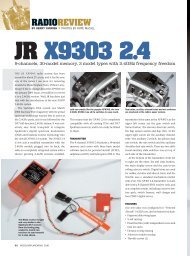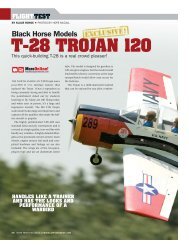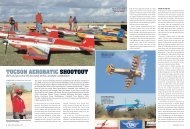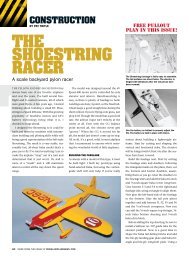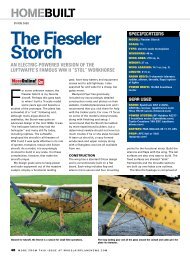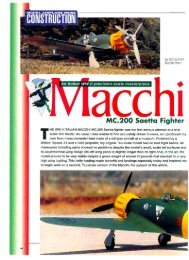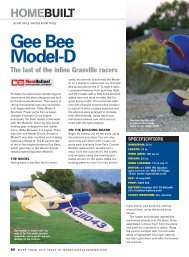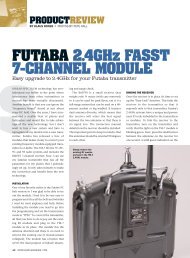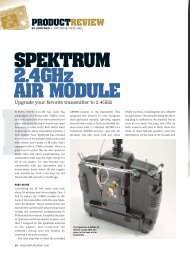You also want an ePaper? Increase the reach of your titles
YUMPU automatically turns print PDFs into web optimized ePapers that Google loves.
DESIGN AND BUILD AN RC BIRD MODEL<br />
The tip feathers operate in a region of up-flow as the vortex begins to form around the wingtip. They have a large negative angle relative to the wing but are generating<br />
upward lift and a small amount of forward thrust. When used differentially as ailerons, the difference in lift produces a roll, and the difference in thrust causes a small<br />
yaw in the same direction. (These birds are pretty clever!)<br />
Initial setting: no roll, slight adverse yaw<br />
Final setting: good roll, slight proverse yaw<br />
Here, the formers and side sheeting have been added to the<br />
structure.<br />
FLIGHT CHARACTERISTICS<br />
Set the elevator's neutral position so the elevator is<br />
parallel with the stabilizer. If you<br />
are using a computer radio,<br />
program the throttle lever to<br />
control (bias) the two ailerons up<br />
or down together (like flaperons).<br />
Set the tip-aileron neutral position<br />
so that the leading edge of each<br />
aileron is about 1/8 inch below the<br />
wing's leading edge. Add ballast<br />
as necessary to get the CG to the<br />
location shown on the plan. Do<br />
some hand glides in still air to<br />
establish the trim settings.<br />
For slope advocates, this<br />
model is a real floater, as is its<br />
real-life counterpart. Without ballast, it does not<br />
penetrate well but is quite realistic in a fight<br />
88 MODEL AIRPLANE NEWS<br />
destabilizing influence of<br />
the body, heads, beaks and<br />
other lateral areas<br />
forward of the CG.<br />
Artificial vertical fins in<br />
the form of "feet" (ventral<br />
fins) or clear circular discs<br />
near the wingtip, toed-in<br />
about 20 degrees, can be<br />
beneficial for early flights.<br />
The required fin area is<br />
usually quite small (6 to 8<br />
square inches) and can be<br />
reduced or removed as<br />
flight experience increases.<br />
Note: electric motors at<br />
TIP FEATHER CONFIGURATIONS<br />
breeze. If you have a computer radio, you can<br />
experiment with the aileron bias setting in flight.<br />
There should be a position that<br />
allows gentle coordinated turns<br />
with the tip ailerons with no<br />
adverse yaw. If you don't have a<br />
computer radio, try adjusting the<br />
aileron bias on successive flights<br />
to find the best setting. (Don't go<br />
too far upward, or aileron control<br />
will disappear completely.) The<br />
model will be considerably lighter<br />
than the real bird, so experimenting<br />
with ballast is appropriate.<br />
Your Turkey Vulture model will<br />
not only attract attention from<br />
your fellow modelers, but it will<br />
also likely attract some attention from other soaring<br />
birds, such as hawks and ravens.<br />
the front have been tried and are quite<br />
destabilizing. If you intend to try a propeller,<br />
use one of the above techniques to<br />
add some vertical fin area.<br />
STRUCTURE<br />
The outer wing panels of a real bird are<br />
extremely light compared with the rest of<br />
the structure (they're just feathers!). Outer<br />
wing panels should be kept as light as<br />
possible to keep roll inertia low. Heavy<br />
wingtips result in unwanted rolling<br />
oscillations. Unusual wing dihedral<br />
patterns (gull, for example) can be<br />
duplicated by using a full-depth balsa spar<br />
and cutting it to the desired dihedral<br />
shape. For thin wings,<br />
glue carbon fiber to<br />
the top and bottom of<br />
the spar for added<br />
strength. Sheeting the<br />
leading edges (top and<br />
bottom, back to the<br />
spar) will provide the<br />
necessary D-tube section<br />
for torsion<br />
strength. The model's<br />
weight will likely be<br />
considerably less than<br />
that of a real bird,<br />
especially for larger<br />
species, but this difference<br />
is mainly in the<br />
fuselage (body weight<br />
and shoulder muscles).



